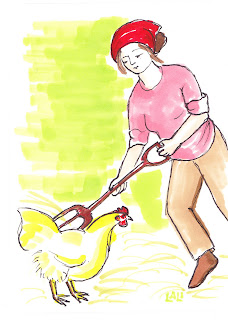If it doesn't rain soon I'll have to change the name of this blog to My Brown Vermont.
We're having a terrific heat wave (highs of 94F) and it hasn't rained in quite a while. The usual values of earth and sky around here (bright green vegetation, muted sky) are now reversed: we havedeep blue skies and dull green vegetation. It looks like the Mediterranean. Speaking of which, the last time I was in Spain it was a very wet summer, and gardeners complained that it was ruining their gardens, where everything is planned with an eye to drought resistance.
But that is not the case in Vermont, and even my intensively planted garden is showing signs of stress, and betraying my aversion to watering. The tomato vines have been dead for a while, but they're full of ripening tomatoes that I must remember to harvest tomorrow morning before it gets hot. I broke down and watered the beans yesterday, because even though the plants looked fine they weren't setting fruit as fast as they should be at this time of year. While I was at it I gave the zucchini some water too, in case it still had some life in it. Amazingly, the kale, chard, eggplants and peppers are unaffected, though I may have to give them a drink in the next couple of days.
Why do I dislike watering so much? Part of it has to do with dragging the hose around, trying to keep it from knocking down plants, and getting water and mud all over myself. Part of it is that I get antsy just standing there holding the hose, wondering if I've watered enough yet. But the main reason is that I'm always afraid that our well will run out of water.
I experienced the waywardness of wells at an impressionable age (30 or so) when we bought our first house in the country. That well was forever running dry and having to "recover" for long periods, like some 19th century neurasthenic. I could not wash more than one load of laundry a day. Watering the garden was out of the question. And if company came to stay, it was axiomatic that we would run out of water in the first 48 hours.
Unlike that one, our present well is faithful and true. In the five years we have lived here, with sometimes ten people in the house for days at a time, it has never failed us. It gives delicious-tasting water, so cold that in hot weather we have to put special trays under the toilet tanks so the condensation won't rot the floors.
Still, you never know. Better safe than sorry. A stitch in time, and all that. With these precepts in mind, yesterday I went into water-conservation mode. I persuaded my husband to adjust the water level in the toilet tanks so they don't use three gallons of water with every flush. I saved the water from freezing some beans--between the boiling and the cooling baths this came to almost a couple of gallons--and gave it to the hostas in front of the house. These are the big-leaved kind of hostas that look like something from outer space. They are super-mulched but were looking dry, so they got the bean water.
Of course hostas look kind of dry at the end of even a wet summer, but how am I to know the difference between a hosta that is dying of thirst and one that is merely tired of summer and wishing for fall? I have the same dilemma with my two little apple trees. They each have a number of fat apples ripening nicely, but the foliage looks rather dull. Should I water them? I can't bear the thought of them languishing before my very eyes, so I guess I'll put the hose at their feet tonight, and let it drip for an hour.
The only thing that is prospering right now is the lavender, which thinks it's been transplanted to a tawny hillside between an olive grove and the wine-dark sea, and from sheer joy has burst into a mass of late-season blooms.
Anxiety
1 day ago


















